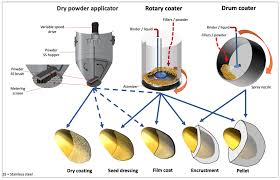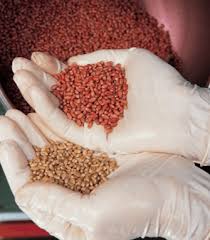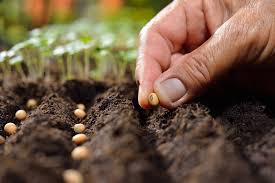In agriculture and horticulture, seed treatment or seed dressing involves applying a chemical, typically antimicrobial or fungicidal, to seeds before planting.
Insecticides are less frequently used. Seed treatments offer an environmentally friendly approach to pesticide use due to minimal quantities required.
Specific products and techniques enhance the growth environment for seeds, seedlings, and young plants. Seed dressing, the most common seed treatment method, applies either a dry formulation or a wet slurry or liquid formulation.
Seed treatment encompasses both products and processes, while seed dressing refers specifically to the process.
Procedures for Seed Dressing and Treatment in Agriculture
Several pre-sowing treatments are applied to agricultural seeds, including pesticide application for controlling soil- or seed-borne pathogens, modifying seed shape/size, and pre-germination before sowing.
Seed Dressing for Pathogen Protection
The most common method, seed dressing, uses dry or wet (slurry or liquid) formulations. Dressings are applied at farms or industries.
Low-cost earthen pots or polythene sheets allow farmers to mix pesticides with seeds mechanically by sprinkling the required chemical quantity.
Read Also: Blackleg (cruciferous plants): Description, Damages Caused, Control and Preventive Measures
Seed Coating for Enhanced Adherence

A special binder enhances formulation adherence to seeds, requiring advanced industrial treatment technology. Seed coating or film coating applies additives like pesticides, nutrients, or nitrifying bacteria to the seed’s external surface (testa), conforming to its shape without modifying it.
A film-forming polymer with active ingredients is sprayed onto seeds suspended in a heated or unheated air column, with a coloring agent added. The coating dries quickly, resulting in free-flowing coated seeds.
Seed Pelleting for Improved Handling
The most sophisticated seed treatment technology, pelleting alters the physical shape of seeds to enhance palatability and handling, requiring specialized machinery and techniques.
It facilitates manual and mechanical handling of small or awkwardly shaped seeds by encasing them in inert materials like montmorillonite clay, which may incorporate pesticides or form a coating for seed dressing.
Read Also: 17 Medicinal Health Benefits Of Lotus Seed (Nelumbo nucifera)
Thermal Seed Treatment for Disease Control

Among the earliest seed treatments, thermal methods include warm water (45°C, 2 hours), hot water (52°C, 10 minutes), or hot air/steam treatments.
Warm or hot water treatments effectively prevent or reduce Fusarium disease, often matching the efficacy of chemical seed dressing.
Essential Oils for Organic Seed Treatment
Organic treatments, such as essential oils and organic acids, replace disallowed chemical treatments in organic agriculture, particularly for orthodox seeds.
Advantages and Disadvantages of Seed Dressing in Agriculture
1. Advantages of Seed Dressing
- Prevents further growth of pathogens adhering to seeds.
- Protects sown seeds and seedlings from soil-borne diseases.
- Ensures even germination and uniform growth.
- Facilitates microbial inoculation for nodulation in leguminous crops.
2. Disadvantages of Seed Dressing
- Techniques like coating and pelleting exceed the capabilities of many farmers.
- Treated seeds increase production costs due to higher expenses.
- Treated seeds are poisonous and unfit for consumption, leading to seed wastage.
- Domestic animals and children face risks from exposure to treated seeds.
Recommended Seed Treatments for Agricultural Crops
| Crop | Pest/Disease | Seed Treatment | Remarks |
|---|---|---|---|
| Sugarcane | Root rot, wilt | Carbendazim (0.1%) 2 g/kg seed; Trichoderma spp. 4–6 g/kg seed | For seed dressing, metal seed dresser, earthen pots, or polythene bags are used. |
| Rice | Root rot disease | Trichoderma 5–10 g/kg seed (before transplanting) | -do- |
| Rice | Other insects/pests | Chlorpyriphos 3 g/kg seed | -do- |
| Rice | Bacterial sheath blight | Pseudomonas fluorescens 0.5% W.P. 10 g/kg | -do- |
| Rice | Root knot nematode | Seed soaking in 0.2% Monocrotophos for 6 hours | -do- |
| Rice | White tip nematode | Seed soaking in 0.2% Monocrotophos solution | -do- |
| Chillies | Anthracnose, damping off | Trichoderma viride 4 g/kg; Carbendazim @ 1 g/100 g seed | -do- |
| Chillies | Soil-borne fungal infection | Trichoderma viride @ 2 g/kg; Pseudomonas fluorescens @ 10 g/kg; Captan 75 WS @ 1.5–2.5 g a.i./litre for soil drenching | -do- |
| Chillies | Jassid, aphid, thrips | Imidacloprid 70 WS @ 10–15 g a.i./kg seed | -do- |
| Pigeon pea | Wilt, blight, root rot | Trichoderma spp. @ 4 g/kg seed | For seed dressing, metal seed dresser, earthen pots, or polythene bags are used. |
| Pea/cowpea | Root rot | Bacillus subtilis; Pseudomonas fluorescens; Soil application @ 2.5–5 kg in 100 kg FYM or Carbendazim/Captan 2 g/kg seed | -do- |
| Pea/cowpea | White rot | Thiram + Carbendazim 2 g/kg seed; Carbendazim/Captan 2 g/kg seed | -do- |
| Tomato | Soil-borne fungal infection, early blight, damping off, wilt | T. viride @ 2 g/100 g seed; Captan 75 WS @ 1.5–2.0 g a.i./litre for soil drenching; Pseudomonas fluorescens and V. chlamydosporium @ 10 g/kg as seed dresser | For seed dressing, metal seed dresser, earthen pots, or polythene bags are used. |
| Leguminous Vegetables | Soil-borne infection | Trichoderma viride @ 2 g/100 g seed | -do- |
| Leguminous Vegetables | Nematode | Carbofuran/Carbosulfan 3% (w/w) | -do- |
| Wheat | Termite | Chlorpyriphos @ 4 ml/kg seed or Endosulfan @ 7 ml/kg seed | For seed dressing, metal seed dresser, earthen pots, or polythene bags are used. |
| Wheat | Bunt, false smut, loose smut, covered smut | Thiram 75% WP; Carboxin 75% WP; Tebuconazole 2 DS @ 1.5–1.87 g a.i./kg seed; T. viride 1.15% WP @ 4 g/kg | -do- |
| Cruciferous Vegetables | Soil/seed-borne diseases (damping off), root knot nematode | Trichoderma viride @ 2 g/100 g seed; Captan 75% WS @ 1.5–2.5 g a.i./litre for soil drenching; Pseudomonas fluorescens and Verticillium chlamydosporium @ 10 g/kg as seed dresser | -do- |
| Potato, Yam, Cassava | Soil and tuber-borne diseases | MEMC 3% WS @ 0.25% or boric acid 3% for 20 minutes before storage | -do- |
| Maize, Sorghum, Millet | Loose smut, covered smut, leaf stripe, termite | Carboxin 75% WP; Thiram 75% WP @ 1.5–1.87 g a.i./kg seed; Chlorpyriphos @ 4 ml/kg seed | -do- |
| Capsicum, Pepper | Root knot nematode | Pseudomonas fluorescens 1% WP, Paecilomyces lilacinus, and Verticillium chlamydosporium 1% WP @ 10 g/kg as seed dresser | -do- |
Source: Directorate of Plant Protection, Quarantine and Storage
Seed treatment encompasses both products and processes, with seed dressing as the most common method. Conventional agrochemicals have long protected seeds from seedbed stresses.
Specific products and techniques improve the growth environment for seeds, seedlings, and young plants. Different seeds require distinct dressing methods based on type and purpose, making pre-sowing seed dressing essential.
Do you have any questions, suggestions, or contributions? If so, please feel free to use the comment box below to share your thoughts. We also encourage you to kindly share this information with others who might benefit from it. Since we can’t reach everyone at once, we truly appreciate your help in spreading the word. Thank you so much for your support and for sharing!

